This post may contain affiliate links. Please read our disclosure policy.
Muhammara, a roasted red pepper walnut dip, has such great texture and flavor. The savory and sweet flavor is always a winner, and you’ll be handing out the recipe left and right!
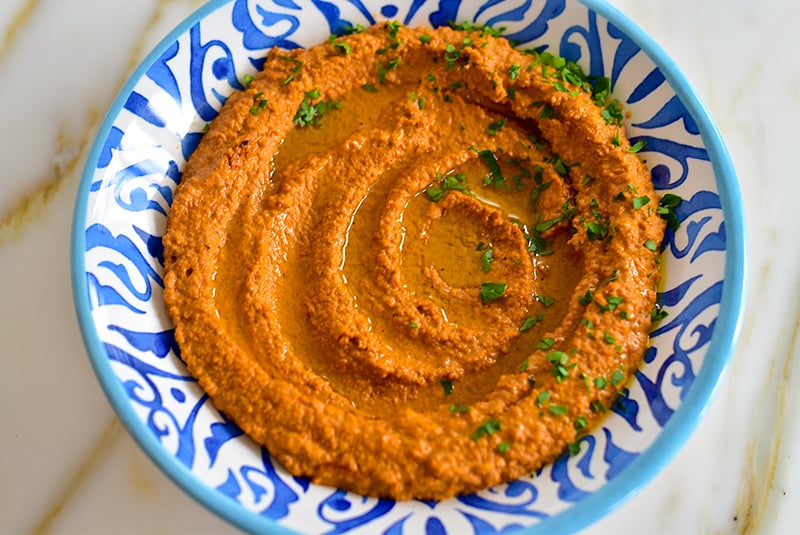
What is Muhammara?
Muhammara (mu-HUMM-a-da) is a Middle Eastern roasted red bell pepper dip. This delicious dip is both savory and sweet with a little heat from the red pepper flakes. An amazing combination of flavors and texture too, with panko breadcrumbs in the mix.
It originated in the Syrian city of Aleppo and made its way around the Middle East. You may have seen jars of it at the store, but there’s no way you can beat this homemade muhammara recipe! If you are a fan of flavorful dips, you have to try this out. The method is simple and the results…so very good.
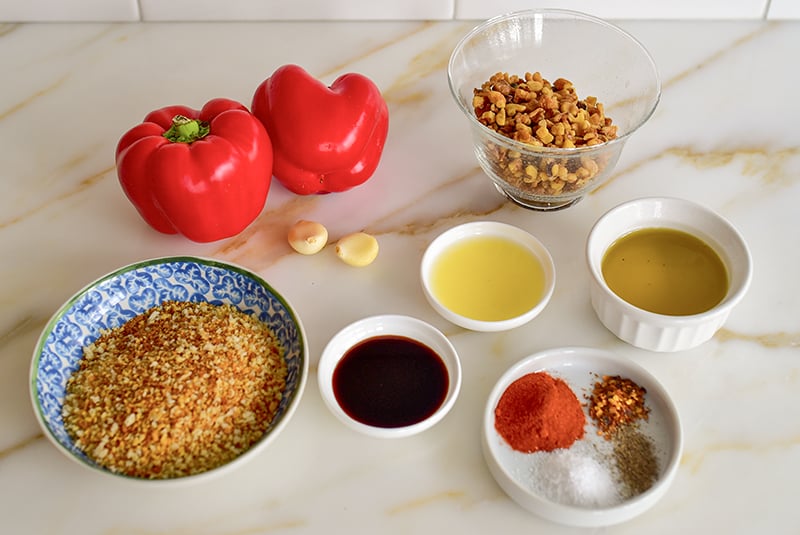
Ingredients
- Bell peppers – Roasting and peeling the bell peppers before using them in this recipe will give so much flavor and texture. You can also use jarred roasted bell peppers, but be sure to peel the skin off.
- Walnuts – Toast the raw walnuts first to add a warm nutty flavor.
- Panko breadcrumbs – The breadcrumbs thicken the dip and add texture. Toasting it first heightens the warm flavor.
- Pomegranate molasses – To add a bold sweetness with a touch of tanginess.
- Garlic – You can leave the peeled cloves whole, as this dip comes together in a food processor.
- Aleppo chili pepper or red pepper flakes – For a touch of heat.
- Lemon juice – For extra tangy flavor.
- Spices – I like to use a delicious combination of paprika, cumin, salt, and black pepper.
- Olive oil – Use extra virgin olive oil for the best flavor. This goes both in the dip and drizzled liberally on top.
- Fresh Herbs – chopped parsley, mint, or cilantro add a bright color and flavor to the finish
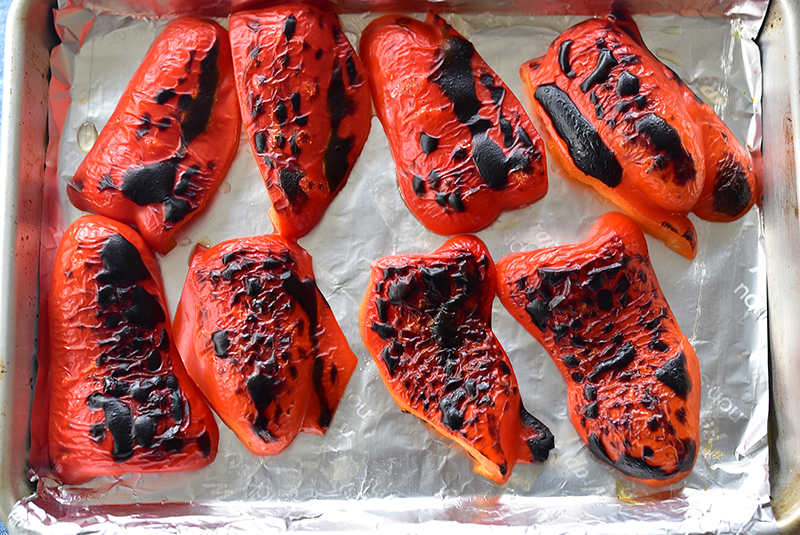
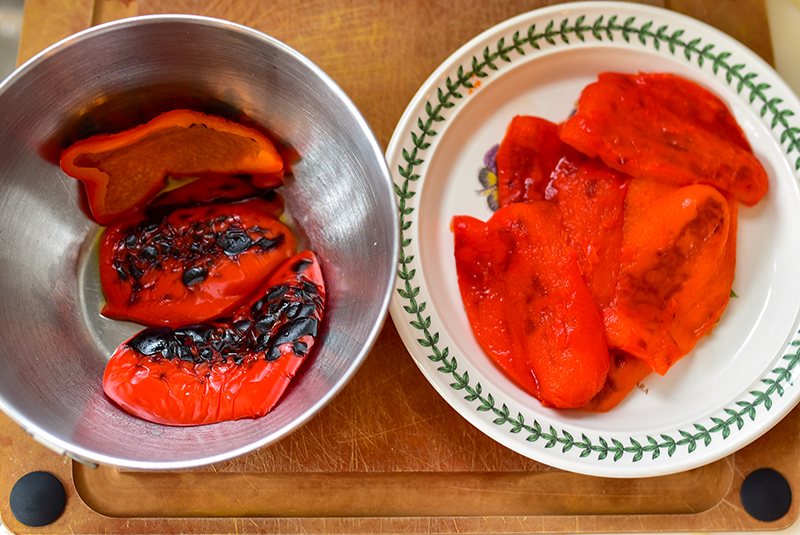
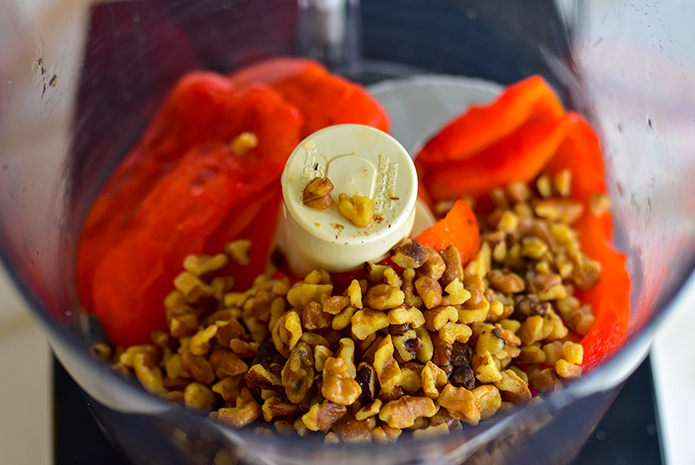

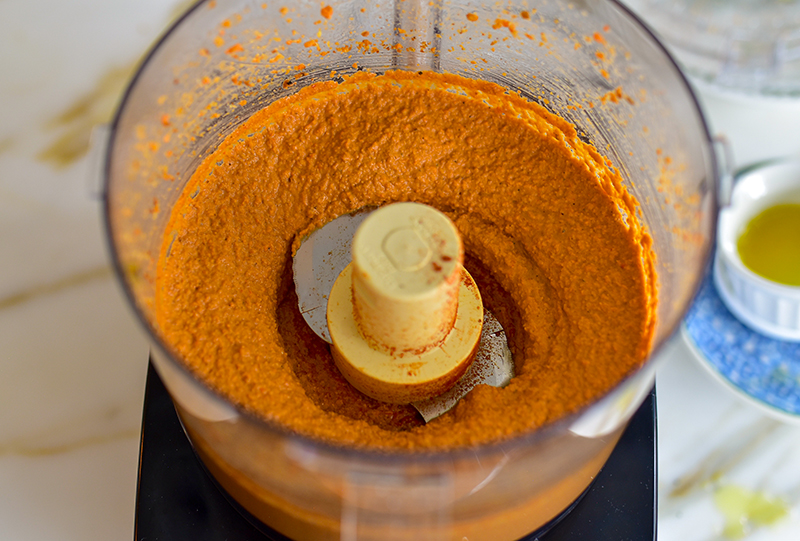
What Can I Use to Substitute for Aleppo Chili Pepper?
Having originated in Aleppo, Syria, the traditional choice of chili pepper in muhammara dip is Aleppo chili pepper. If you can’t find it or don’t have it on hand, feel free to swap it out for red pepper flakes, cayenne pepper, or ancho chili pepper.
What to Serve with Muhammara
The most popular way to serve muhammara is as a dip with warm pita bread, pita chips, or fresh veggies. You can also serve it as part of a mezze platter along with other dips like homemade hummus and Lebanese baba ganoush.
You can also use muhammara as a sandwich spread, in wraps, or spooned atop chicken, grilled meats, or fish.
When serving as a dip, be sure to drizzle the olive oil generously over the top to help prevent it from drying out.
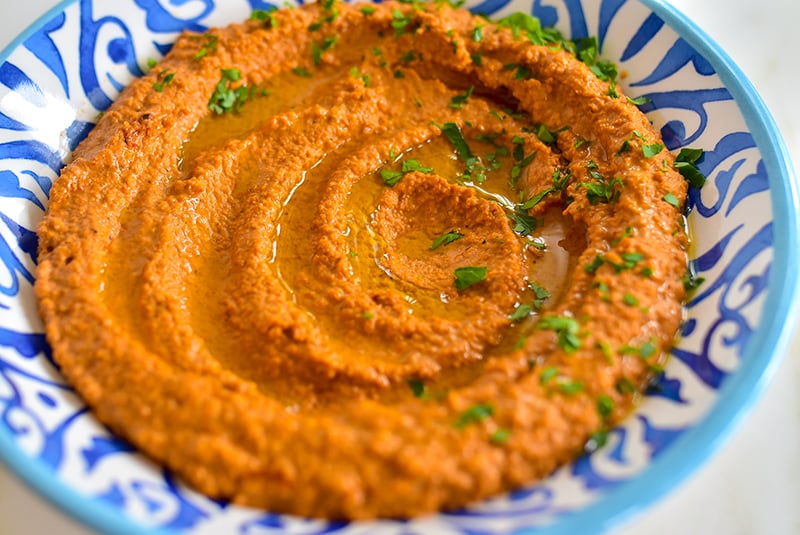
Frequently Asked Questions
The key ingredients in muhammara are roasted red peppers, toasted walnuts, breadcrumbs, garlic, chili peppers, extra virgin olive oil, and tangy pomegranate molasses. Different people will add their own spin to it using spices and seasonings. My recipe adds lemon juice, paprika, and cumin.
Muhammara tastes savory, sweet, tart, and spicy all at once. It’s a complex blend of flavors and it’s absolutely delicious!
No, while muhammara is a dip made with roasted red bell peppers, harissa is a condiment made with dry chili peppers. Harissa is also spicier, and from Tunisia, whereas Muhammara is from Syria.
Yes! Muhammara can be kept in an airtight container in the refrigerator for about a week.
You can store it in a freezer bag or airtight container and keep it in the freezer for up to 3 months. Defrost it in the fridge overnight and give it a good stir before serving chilled or at room temperature.
Yes, you can put the ingredients in a deep bowl and use an immersion blender, or purée it in a blender.
Pomegranate molasses is a traditional ingredient in muhammara. I love pure pomegranate molasses from Lebanon, which I sell in my online shop. If you must, you can use balsamic vinegar as a substitute.
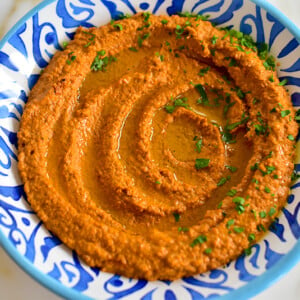
Muhammara Recipe
Ingredients
- 2 red bell peppers, roasted and peeled
- 1 cup walnuts, toasted
- 2/3 cup fresh breadcrumbs or panko, toasted
- 2 teaspoons pomegranate molasses
- 2 cloves garlic
- 1 teaspoon Aleppo pepper or red pepper flakes
- 2 tablespoons lemon juice
- 1 teaspoon paprika
- 1/2 teaspoon cumin (optional)
- 1 teaspoon kosher salt
- Few grinds black pepper
- 4 tablespoons extra virgin olive oil, plus more for finishing
- 1 teaspoon chopped parsley, mint, or cilantro
Instructions
- Combine the peppers and walnuts in a food processor and blend until smooth. Add all of the remaining ingredients except the olive oil and pulse until smooth.
- With the processor running, add the olive oil slowly and blend until the oil is completely incorporated. Turn off the processor and scrape down the sides of the processor bowl as you go.
- Serve the muhammara in a small bowl, chilled or room temperature. Drizzle olive oil liberally over the top and finish with the chopped herbs.
Notes
Nutrition
Nutrition information is automatically calculated, so should only be used as an approximation.
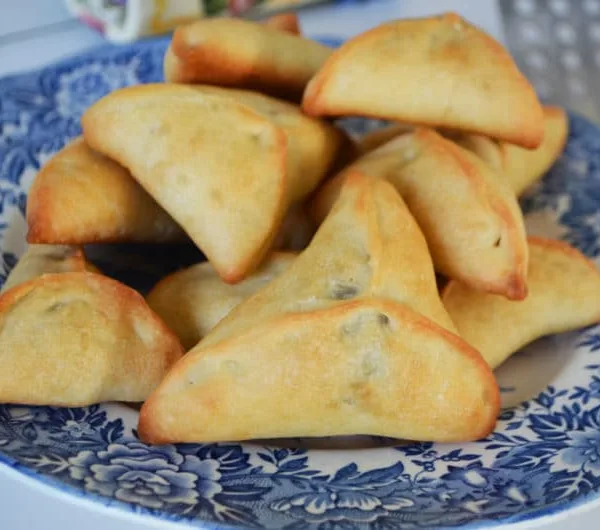
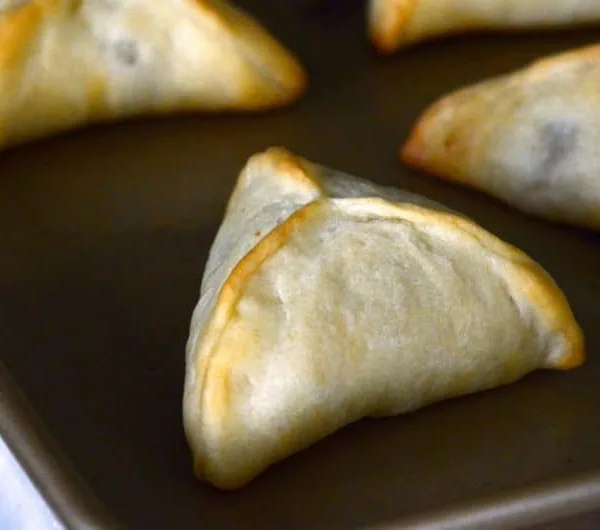
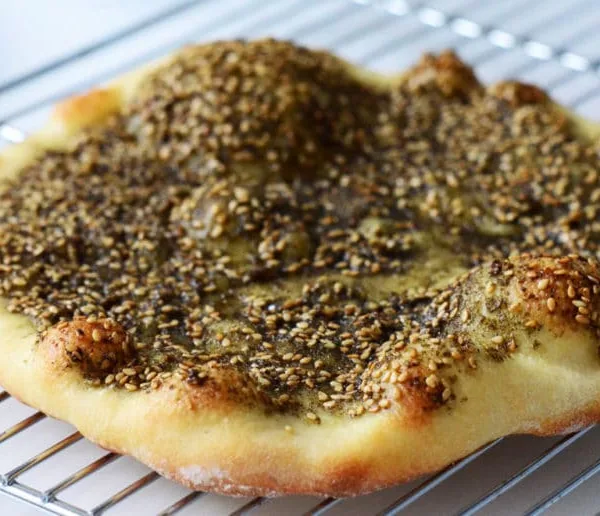
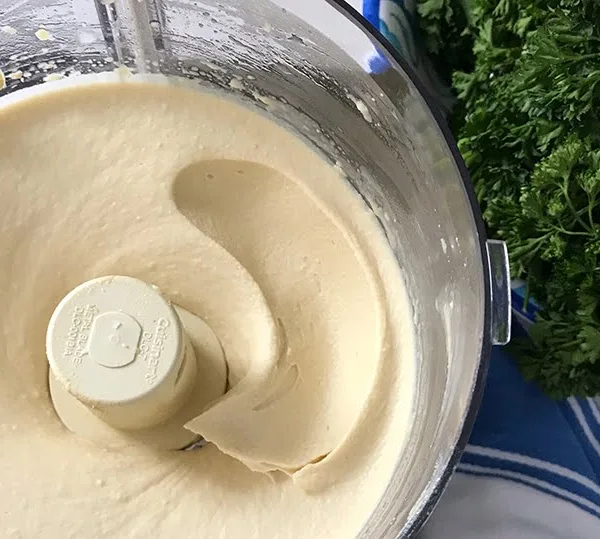







I plan to make this for Memorial Day weekend. Can I make on Wednesday to serve on Saturday?
Hi Kathy, you sure can make muhummara three days in advance, no problem. Delicous! Enjoy!
Thank you for sharing. I have really enjoyed it.
So glad Ranam, thank you!
I love this recipe, unique and deep flavor, easy to make too. The only issue I had is I think blending with the olive oil made it bitter. I did as little as possible in the food processor, but next time perhaps I’ll try just whisk it in my hand. Also wonder if pistachio / walnut combination might work.
So delicious! Interesting about the olive oil, and that will depend entirely on your oil and its flavor. I think this would be excellent with some pistachios in the mix, nice idea.
Thanks! Yes, I believe you’re correct, a different olive oil should remedy the issue rather than avoiding the food processor.
Maureen, I had Muhammara Soup at a Lebanese restaurant and it was sooooo good! It was simply described as roasted red peppers, spices and garlic. Could you come up with a Muhammara Soup recipe?
This one had a little kick.
Ohhhh wow that sounds delicious. A great idea that I look forward to working on! Thank you!
Thank you so much Maureen!
I often come here for reference for my favorite dishes.
I am making Muhammara for Christmas Evening, celebrating my grandfather who was an immigrant from Lebanon to Brazil.
We live in Portugal now, but tradition around food goes with us wherever we go.
Thanks for sharing.
All the best!
That’s so special Paula! Thanks so much. Please keep in touch!
Ok I am about to try this this week! I failed on thanksgiving at using a different recipe for this.
I can’t wait to try yours and perhaps the toasting is KEY!
Amy, this is such a delicious dip/spread. I hope you love this one as much as we do. Toasting is key! And so are proportions and the tart flavor balance. Keep me posted!! Enjoy!
Thanks for recipe, which I hope to follow and make correctly! But this time used it as a basis and concocted “mu KHA dara” using a bunch of green peppers (both spicy and not)! Roasted the garlic along with peppers and pretty much followed the rest of your recipe! Yummmm!
YUMMMM!
After this new posting of the muhammara recipe I can tell that what I ate from the woman from Aleppo was NOT ajvar. I lived in Macedonia for three years and ate homemade ayvar until it came out of my ears. I would sit in my office in the fall and smell the roasting peppers in the neighborhood. It was definitely muhammara as we discussed it. I had eaten muhammara before in both Syria and Jordan (poor substitute). I had made it also. In Macedonia, they do not put aubergines in the ayvar.
I have made this on a regular basis, since acquiring your cook book Maureen. Has become a favourite with friends and family. I serve it with zaatar pita chips. I may have previously told you that it freezes very well.
It appears that the dip that the woman from Aleppo made was not muhummara, but a similiar looking dish called ajvar, which supposedly hails from Serbia. (After World War II, it became popular throughout Yugoslavia and is nowadays popular in the Balkans). In order to produce ajvar, bell peppers and aubergines (eggplants) are roasted whole and immediately placed in a covered container where they are allowed to steam so that when warm, their skins can be easily removed, along with the seeds. The veggies are then pureed with other ingredients. Ajvar can be mild or hot and is very delicious.
I saw the mention of your book on the NY Times and will purchase it. I lived in Jordan for three years and was able to travel to Syria right before all the trouble started. I ate muhummara there and loved it. Just recently I was in Botswana where my husband is now working and a staff member is from Egypt married to a woman from Aleppo, Syria. As part of a fabulous meal, she made muhummara but she put eggplant in it! It was so delicious I could not stop eating it. I went home almost ill I was so full. I would like to ask her for the recipe but I don’t know if she would reveal this family secret. Have you heard of this variation? Your blog looks fantastic. When people in Jordan wanted really good Arabic food, they went to Lebanese restaurants!
What an interesting variation, Janet. I’ll be looking into it immediately! Thanks for sharing!
Thank you for this recipe! I made it yesterday and it turned out amazing! My husband is from Syria, and it past the taste test with flying colors. We ate it on toasted ciabatta bread and, WOW! I just love your blog and reference it frequently. Thanks for sharing your recipes and information.
How great Jessica, thank you!
Maureen, I used your recipe nearly as it stands and just love the flavors of this Muhummara. I am always looking for new flavor combinations and new spices and spice mixtures. More often than not I change them and make a combination pleasing to me. This recipe stands perfect just as is. Thank you for sharing your stories and recipes. I will be checking out others soon!
What a great compliment, Chris, thanks so much!
Awesome and totally different dip! I have in the last year become allegoric to tahini. My beloved hummus went out the window. This dip might be a wonderful replacement. I hope so!
Oh no, no hummus! This will be a great replacement Carol!
however it is pronounced, this is sooo delicious. and yes, it is wonderful on all manner of foods, and may i say, also, on a spoon. i have wondered about making it myself, and you have convinced me to let someone else do the painstaking work and just delight in other’s efforts.
looking forward to your next delicious blog.
That is a great story, wonderfully told.
Thank you Quinn!
I just made this for a Super Bowl party – tastes amazing! I garnished it with some chopped parsley and mint, and some whole walnuts. Thanks for the recipe!
Great, Kate, thank you and so glad you enjoyed the baba!
Hello Maureen… I just came across your blog for the first time tonight and was happy to see the recipe for Muhammara. Ironically, a friend came back from a vacation in Greece (Salonika) on October and brought back a sampling of ATZIKA, which is the Pontian version of Muhammara… it tasted like the chaimen topping for pastourma if you know what this is. I was awed by the intense flavor and have been looking for recipes. Unfortunately, I only found one and it claims celery as part of the ingredients, which does not seem right to me. Celery is a pronounced flavor in anything and the ATZIKA sample I tasted did not have celery in it. I am going to try your recipe above and see what I can come up with. We are lucky that we have 2 Middle Eastern stores not far from us and shop there whenever we need things. I am sure I have seen the pomegranate molasses but didn’t know how to use it; I do now!!! thank you!
That’s just great Chrysoulla, thank you. I am with you, I have not had muhammara with celery! Enjoy this and let us know how you like it!
I made this for a Thanksgiving appetizer and it was amazing! Thank you so much, it is definitely a new family favorite!
That’s great news!! Thanks for taking time to let me know!
What lovely photos! “I came to understand the muhammara-making as an exercise in both the break-down and build-up of my kitchen ego” — love the narrative that wound up with that insight. So much of cooking and food-prep as I see it winds up at similar points, so it’s hear of other journeys that way, too.
Hello Maureen I tried this last night and it is phenomenal. I added 2 roasted peeled hot red peppers. Best recipe, thanks for sharing! Do you happen to have a recipe for kibbe kaddaba?
Thank you Hiba! Tell me more about kibbe kaddaba…
Hi Maureen,
I love your story and will be trying your recipe very soon. In fact, I am Lebanese but did not eat much Muhammara while in Lebanon. I will make it now though and let my family taste it.
Thanks for sharing your lovely recipe.
Fadia
Thank you so much Fadia! Enjoy the muhammara!
Oh my word! I made this tonight and its DIVINE!! I love your blog! So glad I found it on the Shada Family FB page! Thanks, Maureen!
Actually, moe-hamm-marah is the correct pronunciaton. It’s a dip eaten in South-East Turkey to North-Syria. The Lebanese dialect is different from Syrian dialect.
We did not eat muhammara growing up in Beirut; it was a dip from Aleppo actually and only in the last few years did I see it in restaurant menus; of course, it is also done by the Armenians who settled in and around Aleppo. Most recipes in Arabic cookbooks don’t use fresh bell peppers but i prefer it with them!
I’ve had this in restaurants but never “home-made.” It really is delicious.
If you can’t find dibs roman in your area, you can make your own. It requires just 3 ingredients. Alton Brown from the Food Network has a recipe/directions for creating either pomegranate syrup or molasses (using the same 3 ingredients and simply altering the cooking time). Here is the link:
https://www.foodnetwork.com/recipes/alton-brown/pomegranate-syrup-or-molasses-recipe/index.html